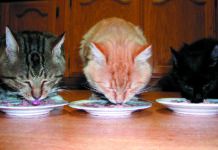- Do a rib check. When you feel your cat’s rib cage, it should be no more padded than the back of your hand.
- If your cat appears to be overweight, add up the number of calories he or she receives each day. Count regular food, treats and table scraps. Be honest. (See article on healthy treats in Catnip, May 2013.)
- Provide daily diet information to your veterinarian during your cat’s wellness examination. “Since obesity can cause other diseases, it is important to work with a veterinarian to have a full medical check-up before starting a weight loss program,” says Dr. Linder. “Other disease conditions may affect the diet selected.”
- Work with your veterinarian to tailor a diet to your pet’s preferences — and home environment. “Every pet I see has different needs both nutritionally and environmentally, so we assess each as an individual and consider the program as a whole.”
- Your vet can help you figure out how many calories your cat should receive each day to lose weight.
- Translate that into daily servings — including treats.
- Experts recommend that you aim for a safe rate of weight loss: one to two percent of your cat’s total body weight per week.
- Don’t forget exercise. If a cat is cleared medically, increased physical activity is a great part of a weight loss program. However, you may need to get creative to increase exercise. “Spreading the food throughout the house, or using laser lights your cat can chase, are ways to increase activity.”
- Monitor your cat’s progress. If he or she refuses food, or has severe or rapid weight loss, talk to your vet. If your cat isn’t losing weight successfully, or has other diseases that create special dietary needs, consider consulting a veterinary nutritionist.



